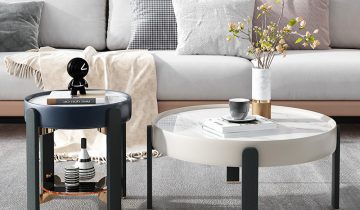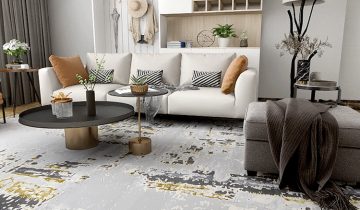Adding a rug to your kitchen and dining room can be a great way to add color, texture, and comfort to the room, whether it’s a runner between the island and the cabinets, a small mat in front of the sink, or a full-size rug covering up hardwood. And, while it might seem counterintuitive to some, given the room’s proclivity for spills and messes, the right kind of rug will improve the space without adding your workload.

Tile, stone, and wood floors are all cold to the touch. This is something that an area rug can help with. A pleasant style and design will help to create a welcoming environment in the kitchen and dining room. An open floor plan, a loft apartment, or a dining room with vaulted ceilings may be a noisy setting. In the kitchen, an area rug can help with noise reduction. Noise is amplified by tile floors, stone counters, steel appliances, and windows, while a rug absorbs it.
Purchasing a rug for the kitchen or dining room should be done carefully. Choose a quality rug and use a rug pad. Inexpensive rugs tend to curl on the edges and provide a tripping hazard. Here are a few things you want to know before purchasing a rug for your kitchen and dining room.
1. Consider the size of the rug

Calculate the size of your region. Rectangular mats for use in front of your sink are usually 2 feet by 3 feet, but if you want more coverage, you can tile them. If you want a runner, measure the length of the galley and subtract a few inches on the sides (at least three inches, but more likely six) to allow room between the cabinets and the rug. Same if you’re getting a rug to fill the space. If the rug is going under a dining table, a good rule of thumb is that it should be the area of the table, plus about three feet all around to keep the chairs on the rug when you scoot them in and out.
Rectangular rug works rectangular dining tables. This solution works in any room size, and the appropriate rug size is determined by the room’s and dining table’s measurements. If you have a rectangular table, a rectangular rug is a way to go. Make sure the rug is large enough for all of the chairs to stay on it when they are brought out – if chairs slip off the rug’s edge, the space will feel smaller and unbalanced.

Consider the smaller options if you’re still undecided on whether an area rug in the kitchen is right for you. In front of the counter where you do the majority of your work, place a patterned, mat-sized rug. By a long area of cabinets and counter room, place a runner-length rug. Is there a seating area on your kitchen island? To protect the floor, place a rug underneath the chairs. Experiment with small rugs and graduate to a larger one to fill your kitchen space.
2. The material of the rug

Flat-weave rugs, in general, are the perfect option for kitchens because they are easier to clean than rugs with a higher pile. Indoor-outdoor rugs (typically made of polypropylene) are a good option because the fabrics won’t absorb spills, but cotton or a mix may be a good choice for a smaller rug that fits inside your washing machine.
There are three methods for minimizing stains. First, pick a rug that can be washed. Synthetic fabrics like nylon and polypropylene are the best to care for when it comes to rugs. Second, look for fabrics that are stain-resistant. Since natural fibers like seagrass and jute are naturally stain-resistant, they’re easy to maintain. Third, pick a style with a variety of colors and patterns. Spills and stains are more noticeable on a solid color rug. If a small stain cannot be removed, chalk it up to Wabi-sabi styling for your kitchen and enjoy it. Remember to read the care directions before you buy a rug to make sure you’re able to put in the effort.
3. The potential for slips

If the rug’s backing isn’t non-slip, put it on top of a non-slip rug pad to keep it from sliding around when you’re working. On tile floors, make sure to use a rug pad and apply rug tape under the edges to keep the rug in place. If you want to put a rug in front of the sink, put a thicker rug pad underneath it to add anti-fatigue properties to make it easier to clean.
4. Matching your Rug with your Kitchen Design

The beauty of a rug is that it is a reasonably low-cost way to update the look of a space! If you just need a pattern, choose one that matches the colors in your kitchen but has a graphic design. If you’re looking for a splash of color, go for it. You can choose something that matches the mood perfectly or provides a contrast (for example, a casual rug in a more formal kitchen) to draw the room in a new direction. A solid-color rug in a lighter shade, on the other hand, should be avoided because it can reveal stains more readily than one in a darker color or pattern.
Follow the manufacturer’s cleaning instructions before you buy your rugs. So that you don’t scratch the floor under your rug, clean it. It’s possible that steam cleaning a rug on a wood floor isn’t a smart idea. When you see a spill, wipe it up right away. This will add to the life of your rug if you aren’t using a material that’s stain resistant.
Source: plushrugs, thekitchn




 No products in the cart.
No products in the cart.